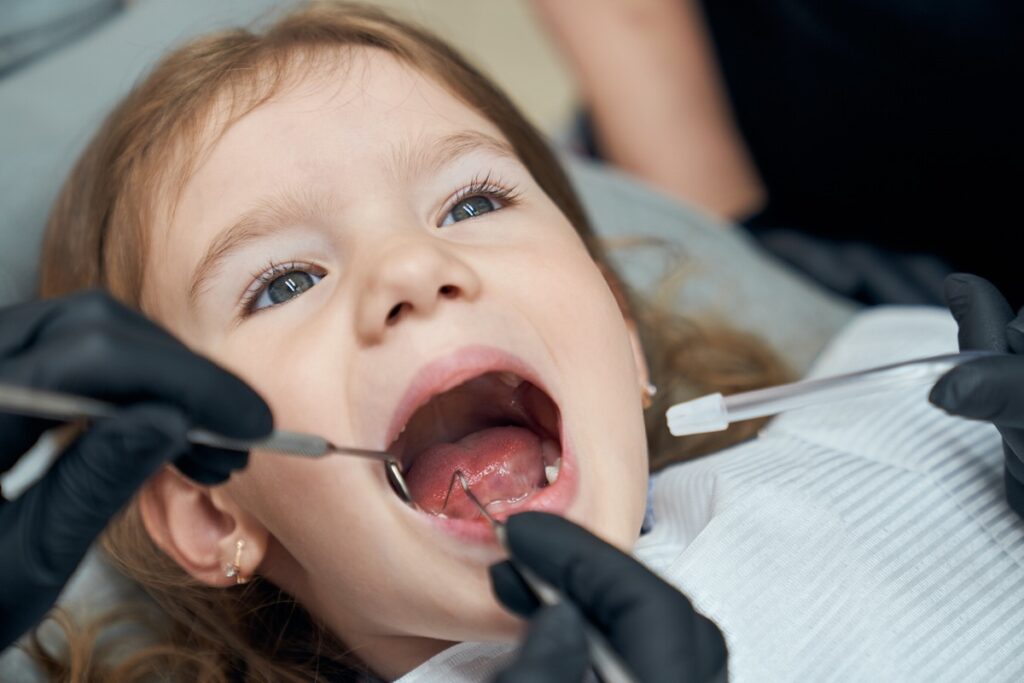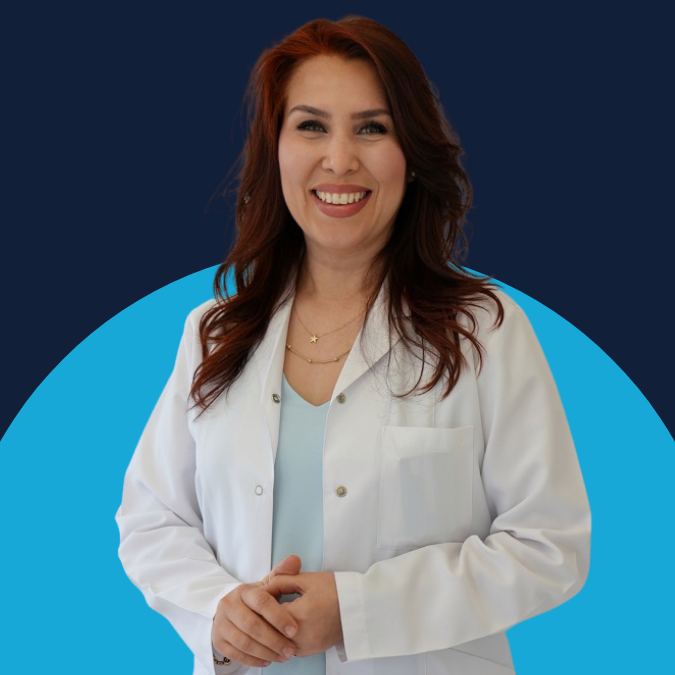Pediatric Dentistry (Pedodontics)
- Home
- Our Treatments
- Pediatric Dentistry (Pedodontics)

What Is Pediatric Dentistry?
Pediatric dentistry is a branch of dentistry that focuses on protecting, treating, and improving the oral and dental health of children. Also known as pedodontics, this specialty specifically addresses the dental care needs of children and aims to help them develop healthy oral hygiene habits.
Why Is Pediatric Dentistry Important?
Having healthy teeth and gums during childhood has a positive effect on a child’s overall health. Pediatric dentistry plays a vital role in maintaining and improving children’s oral health. Establishing proper dental care habits at an early age helps prevent cavities and other dental problems, contributing to a healthier mouth structure as they grow older.
What Are Pediatric Dentistry Services?
- Regular Check-ups: Pediatric dentists perform regular examinations to assess children’s oral and dental health. During these check-ups, dental caries, gum problems, and other oral health issues are detected and treated.
- Cavity Prevention: Pediatric dentists educate children on cavity prevention techniques such as proper tooth brushing, flossing, and maintaining healthy eating habits. They also perform preventive treatments such as fissure sealant applications.
- Treatment: Pediatric dentists treat cavities, gum diseases, dental trauma, and other oral health problems in children. These treatments may include fillings, root canal therapy, tooth extractions, and other restorative procedures.
- Jaw Development and Orthopedic Treatment: Pediatric dentists monitor jaw development and may recommend orthodontic or orthopedic treatments when necessary. These treatments help ensure that the child’s teeth and jaw structure develop in proper alignment.
- Oral Hygiene Education: Pediatric dentists provide oral hygiene education to both children and parents. This education helps children establish regular toothbrushing habits and maintain good oral health.
Frequently Asked Questions About Pediatric Dentistry
Baby teeth contain more organic matter than permanent teeth, making them more prone to decay and allowing them to decay more easily and quickly. Children do not react much in the early stages of decay. As the decay progresses, sensitivity to cold and sweet foods may begin. Later, the decayed tooth will cause pain and discomfort to the child. The pain increases especially when eating. This is because food debris entering the decay puts pressure on the tooth's nerves, causing the pain to increase.
Sometimes, brown spots appear on children's teeth as soon as they erupt, or these teeth may break and fall out. These spots are actually tooth decay, and the teeth break due to decay. The reason for decay occurring at such an early stage is a type of decay called bottle decay. Breast milk or cow's milk, the most important nutrients in infant feeding, naturally contain sugar. If a baby feeds on breast milk or a bottle before going to bed or during sleep, the milk accumulates in the mouth, creating an environment conducive to bacteria decaying the teeth.
- Prevent your baby from developing the habit of falling asleep with a bottle in their mouth at night.
- Do not add sweeteners such as sugar, honey, molasses, or biscuits to the milk in the bottle.
- Always give your baby water to drink after feeding, or brush their teeth if possible.
- Once their first teeth start coming in, clean their teeth by wiping them with a clean, damp cloth or gauze pad after nighttime and morning feedings.
Untreated baby tooth decay can lead to pain, bad breath, difficulty chewing, nutritional problems, and an unsightly appearance. Untreated dental problems during this period can lead to crooked teeth, jaw development problems, and general health problems (ranging from rheumatism to heart disease) in the future. Therefore, cavities in baby teeth should be treated without falling into the misconception that “they will be replaced anyway.”
Early loss of baby teeth, especially in the back molar regions, can cause certain problems during permanent tooth eruption. This is because the permanent tooth that will come in next to the empty space left by the lost tooth may not erupt properly and remain impacted, or it may erupt from a different location, causing malocclusion. In such cases, orthodontic treatment (braces) will inevitably be required in the future. If a primary tooth must be extracted early for various reasons, fixed/removable space maintainers should be made to prevent the adjacent teeth from shifting and closing the space.
When the baby is 6-8 months old (i.e., when the first teeth appear in the mouth), the cleaning process should begin. After breakfast in the morning and before going to bed at night, it is appropriate to wipe and clean the teeth (at least the chewing surfaces) by moistening a clean gauze or cotton cloth.
It is appropriate to start using a toothbrush after the child's back teeth appear (around 2.5-3 years old).
It is very difficult to teach preschool children a technique for brushing their teeth. At this age, it is important to instill the habit of brushing teeth in the child. When brushing their teeth, children often brush only the visible or easily accessible surfaces of their teeth. However, to prevent cavities, it is necessary to clean the surfaces between the teeth and the chewing surfaces much more thoroughly. Therefore, it is a good idea for parents to check after brushing.
Toothbrushes that are appropriate for the size of the child's mouth, soft, and made of nylon bristles should be used. Hard brushes are not suitable for use as they will wear down the teeth. Just as you cannot sweep with an old broom, you cannot brush your teeth with an old toothbrush. The bristles must be replaced as soon as they become worn (approximately every 6 months).
After breakfast in the morning and before going to bed at night, just three minutes of effective brushing is sufficient. Like any good habit, the habit of brushing teeth will be acquired during childhood.
A vaccine or medication that can completely prevent cavities has not yet been developed. However, some materials are currently used to reduce the number of cavities, one of which is called a “fissure sealant.” Cavities usually start in the grooves called “fissures” on the chewing surfaces of molars and premolars.
This material covers the grooves, preventing microbes, food debris, etc. from entering the area and thus preventing decay from starting. This procedure can also be applied to permanent molars and premolars that emerge from the age of 6 onwards.
Another way to prevent decay is to increase the teeth's resistance to decay. This resistance is achieved by applying topical fluoride to the teeth.
In cases where children's teeth are damaged in accidents, immediate intervention is essential. An accurate diagnosis is crucial. To this end, your dentist will ask you when and where the accident occurred, the direction of the impact, and whether there was any loss of consciousness, vomiting, memory loss, etc. following the accident. Based on the information provided, the most appropriate treatment can be administered.
Dental injuries in children can sometimes cause the permanent tooth to become completely dislodged from its socket. In this case, you should go to your dentist immediately with the tooth that has come out. In the meantime, the tooth should be stored in a glass of milk, or if milk is not available, in clean water.
This condition, which is often seen in incisors and canine teeth, can cause baby teeth to fall out late. In this case, the baby teeth may need to be extracted. In some cases, especially when the upper canine teeth protrude more forward and upward, orthodontic treatment (braces) may be necessary to move the permanent tooth into its proper position.
Baby teeth typically grow in with gaps between them. Because of the size difference between baby teeth and permanent teeth, these gaps help ensure there is enough space for the permanent teeth to come in. These gaps between teeth also make it easier for your child to clean their teeth.
From an orthodontic perspective, your child's first check-ups should be scheduled around the age of 7-8, when permanent teeth begin to erupt. This allows for the early diagnosis of potential problems. Early diagnosis increases the success rate of orthodontic treatment, as it does with any other type of treatment.
Gum diseases seen in children generally occur during the teething period as mild inflammation of the gums around newly emerging teeth or in cases of inadequate brushing. During this period, the gums are red, swollen, and prone to bleeding. Similarly, mouth breathing and thumb sucking habits also negatively affect gum health. Except for more severe cases associated with systemic diseases, ensuring oral hygiene and cleaning the teeth when necessary will be sufficient for treatment.
Thumb sucking or pacifier use is normal in children. Most children stop this habit before reaching the age of 4, which does not cause any damage to their teeth. Children who continue this habit after turning 4 should be examined by a pediatric dentist (pedodontist) or orthodontist. However, in most children, there is no need to worry about the sucking habit until the age of 6, when the front teeth erupt.
If a child still has a prolonged and persistent sucking habit at the age of 6, their upper front teeth will be pushed outward, their lower teeth will tilt inward, the alignment of the upper and lower jaws will be disrupted, and the palate area will narrow.
Your child should have their first visit to the dentist when they turn one. This way, they will feel comfortable in the dentist's chair in later years and also develop regular and quality oral hygiene habits.
Decayed baby teeth should be treated just like permanent teeth. The pulp (tooth nerve) inside baby teeth, which contains pain receptors, covers a large part of the clinical crown of the baby tooth visible in the mouth. This can cause severe pain as a result of the tooth's nerve becoming inflamed due to bacteria in the decayed cavity.
Bacteria seeping from the decay cavity into the pulp cause it to become inflamed and die. As a result, necrotic tissue debris forming along the crown and root canal of the tooth causes an abscess to form at the root tip. The way to eliminate this abscess is to perform root canal treatment on the baby tooth.
Baby teeth should be kept in the mouth until the permanent teeth that will replace them erupt. In cases where early extraction is necessary, a space maintainer should be applied.
Appointment Form
Please fill out the form below, and our team will contact you shortly.
Why Reyhan Arıkan?
We bring together knowledge, experience, and technology.
Your Smile Is Our Priority
With our experienced team, we are here for you to achieve healthy and beautiful smiles.
Reliable Dental Health
We add value to your smiles with over 20 years of experience and a modern approach.
Happy Patients
The satisfaction of thousands of our patients is our greatest achievement.
Our doctors
Our doctors are always by your side.
At our clinic, we offer you the most up-to-date treatment methods with our physicians, each of whom is an expert in their field. We are here to help you achieve a healthy and aesthetic smile with our experience, care, and modern technology.

Reyhan Arıkan
Dentist

Elif Seymen
Dentist

